The taste of Tobago in just one dish
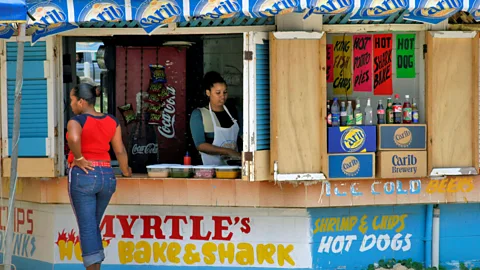 RGB Ventures/Alamy
RGB Ventures/AlamyWhile most of Tobago's food specialties – such as shark and bake, doubles and callaloo – originated in Trinidad, crab and dumpling is quintessential Tobago.
The birdsong was the loudest that I'd ever heard, backed by the rolling crash of the ocean. Hummingbirds whirred. Trees were weighed down with ripe mangoes, tangled creepers and leaves the size of frisbees. I was searching for crabs with local chef Sherwin Clark in the stretch of Tobago's emerald coastal forest that backs Englishman's Bay, whose apricot sands are patterned not by footprints but by the swish of iguana tails.
Catching the crabs was the first step in making crab and dumpling, Tobago's signature dish.
Locals are rightly proud of this salty, spicy, coconut-milk-infused curry that's made with sweet local manicou crabs and served with cornmeal-and-flour dumplings. That's partly because Tobago, the smaller, north-easterly island of the Republic of Trinidad & Tobago, is often overshadowed by its larger sibling. Most local food specialties, such as shark and bake, doubles and callaloo, originate in Trinidad and are eaten across both islands, but crab and dumpling is quintessential Tobago.
"Trinis come over here to eat it. It's a Tobago thing," Clark told me.
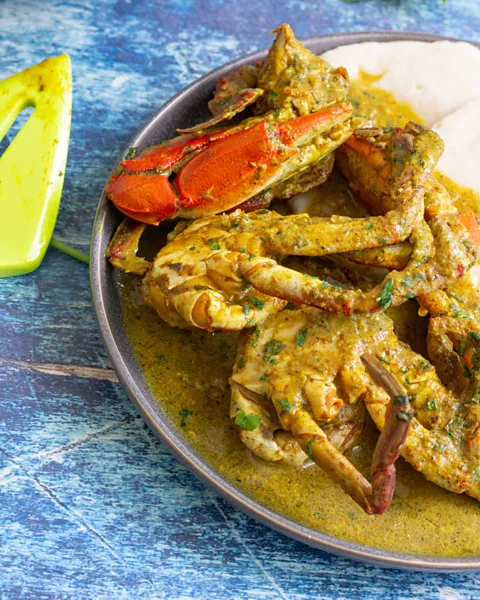 Renee Robley
Renee RobleyThe other reason is that the dish is intimately connected with the Tobagonian landscape. Tobago is a land of plenty, with astonishing biodiversity including more than 260 species of birds. It's also home to the world's oldest protected rainforest, which is where these unique freshwater land crabs live, scuttling along the forest floor and in mountain streams rather than the marine environment usually associated with crabs. While sea crabs are also abundant in Tobago, the sweeter land crab meat is preferred for the dish.
"Crab and dumpling is the epitome of Tobago's food landscape. It is an 'ah we' dish, meaning that it comes from us, it is part of us," said Renee J Robley, who blogs on Caribbean cuisine at Thisbagogirl.
Nowadays associated with beach life and good times, crab and dumpling has roots in a shameful history. Like other British West Indian colonies, 18th-Century Tobago was exploited by the British as a base for sugar plantations, maintained through the labour of enslaved Africans and, later, indentured Indians.
Lizzie Collingham, culinary historian and author of The Hungry Empire, describes the conditions that African slaves endured here as "brutal", adding that they were given cornmeal and substandard saltfish to eat, and thus looked for other means of nutrition.
"It's likely the African slaves were familiar with catching crabs, as they would have probably caught them in the mangrove swamps of West Africa," she said. The enslaved African also introduced dumplings to the Caribbean, called "journey cake" or "Johnny cake", which they could transport easily and cook on hot stones.
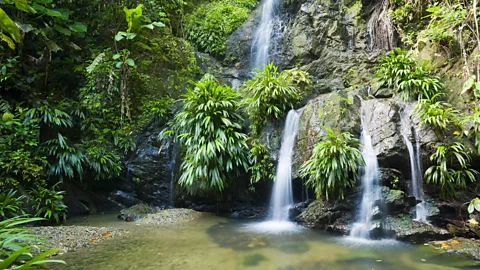 DebraLee Wiseberg/Getty Images
DebraLee Wiseberg/Getty ImagesFollowing the abolition of slavery in the 19th Century, the British were faced with a problem: where to find workers for their plantations. This coincided with the Industrial Revolution, which caused cheap, machine-made English cotton to flood the Indian market and put thousands of Indian textile workers out of work. The British seized the opportunity, and over the next few decades transported more than 140,000 Indians to Trinidad & Tobago as indentured labourers. Workers signed contracts – that they were often unable to read – for five years servitude on minimal pay.
"The labourers wouldn't have been able to bring anything with them," Collingham said. "But the British would have been aware that they would have to provide spices for the Indian labourers. The British imported their own curry powder and gave it as a ration."
Over time, these Indian and African traditions and flavours merged to form the beloved dish, which is now sold from clapboard beach kiosks across the island, painted in lime-green, papaya-orange and mango-yellow, the colours of the Caribbean.
Among these, on Store Bay Beach close to Pigeon Point, is Miss Trim's, Tobago's best-known crab and dumpling stand. Meisha Trim is the second-generation Miss Trim to run the place; her mother started selling her homecooked food on a street stall, graduating to the beach hut around 30 years ago. When I visited, Trim proudly told me how the Tobagonian mix of cultures created the dish.
"It's a fusion of the best of us, of our African and our Indian heritage, so we have the spices from India and the coconut milk, fused together with the local seafood."
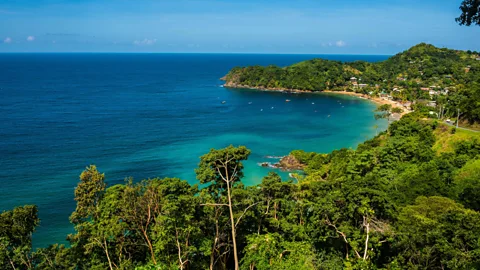 Westend61/Alamy
Westend61/Alamy"It's the food of the beach," she added. "If you're going to a beach lime [event], or after harvest at the church, if you want to celebrate anything that's essentially Tobagonian, you will eat crab and dumpling."
I was eager to try it myself, and luckily Clark and I caught six crabs using his homemade wooden boxes with trapdoors. In the forest, he'd pointed out some small hollows in the sandy floor: these were the crab burrows, close to a stream. As he'd set the traps, squeezing mangoes plucked from a nearby tree around the burrows to lure them, he told me that early evening is the best time to snare land crabs, when he could sometimes catch tens at a time. When we returned later that evening, we found six manicou crabs in the traps, which he showed me how to hold safely, avoiding their fronts, telling me that "their bites are like knives".
To cook them, we headed to Clark's yellow-slatted restaurant, Marguerite's, located just behind the beach in Castara, a remote Tobagonian village that prides itself on its authentic Caribbean cuisine. Marguerite's is one of the best places to eat crab and dumpling in Tobago. Sherwin comes from a long line of cooks: his parents run one of the village's open-air ovens and two of his brothers have restaurants, too. His grandmother taught him the recipe, he told me, and he has been catching the crabs since he was a child.
In his yellow-painted kitchen, with saucepans hanging on the walls and lace curtains at the windows, Clark showed me the dough he'd prepared for the dumplings, a mix of cornmeal, wheat flour and water. He marinated the crabs in ginger and garlic, and began the sauce by pouring a ladle of vegetable oil to heat with a clove of garlic, then added curry powder mixed with a little water, which sizzled in the oil, sending up a fragrance of mingling spices. Once the sauce was bubbling, Clark added the crabs and a squirt of ketchup, followed by a litre of coconut milk.
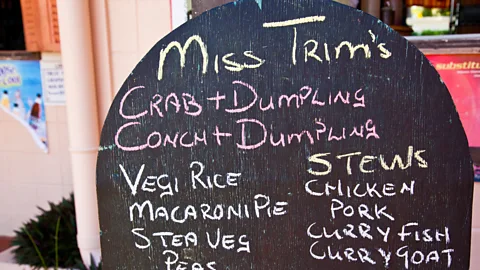 dbtravel/Alamy
dbtravel/AlamyAs the curry simmered, the flavours turning richer as they merged with the sweet-scented coconut, Sherwin rolled out the dumplings into half-moon shapes. He cooked them in boiling water for around 10 minutes while the curry sauce bubbled, reducing, alongside. He added a little fresh red chilli pepper to the sauce, "but only for taste, not for spice". In just half an hour, the dish was ready to eat.
We sat at a table with a view onto the trickle of the river that runs through Castara out to the hot-blue Caribbean Sea, watching Rasta fishermen hauling in their nets. Clark watched with amusement as I started trying to eat the dish with a knife and fork. These are crabs that are all leg with not much body, and it soon became clear that the only way to eat it was to dig in with both hands.
"I prefer to eat crab and dumpling at home, so I can relax into the mess," he told me, laughing.
It was worth the effort to eke out slivers of the delicacy, though: richly flavoursome and perfectly spiced, the sauce was elevated by the sweet crab morsels and soaked up by the dumplings. Trim was right when she'd told me, "It's an assault on all your senses. You smell it first, the smell is very distinct, the gravy is thick and rich because of the coconut. The spices come at you very fast."
According to Trim, sometimes people just order the crab gravy if they don't want the mess of cracking open the crab. However, getting the flavour from the crab legs is like unlocking the essence of Tobago. It's the beach, sunshine, the time to crack the crab. It's a fusion of ingredients from afar, a tangled feast born out of necessity, and a rich, intermingled culture that's as captivating as the sauce.
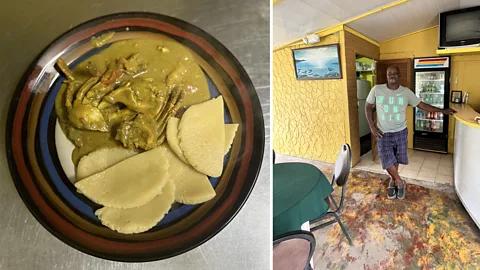 Abigail Blasi
Abigail BlasiCulinary Roots is a series from BBC Travel connecting to the rare and local foods woven into a place’s heritage.
--
Join more than three million BBC Travel fans by liking us on Facebook, or follow us on Twitter and Instagram.
If you liked this story, sign up for the weekly bbc.com features newsletter called "The Essential List". A handpicked selection of stories from BBC Future, Culture, Worklife and Travel, delivered to your inbox every Friday.
